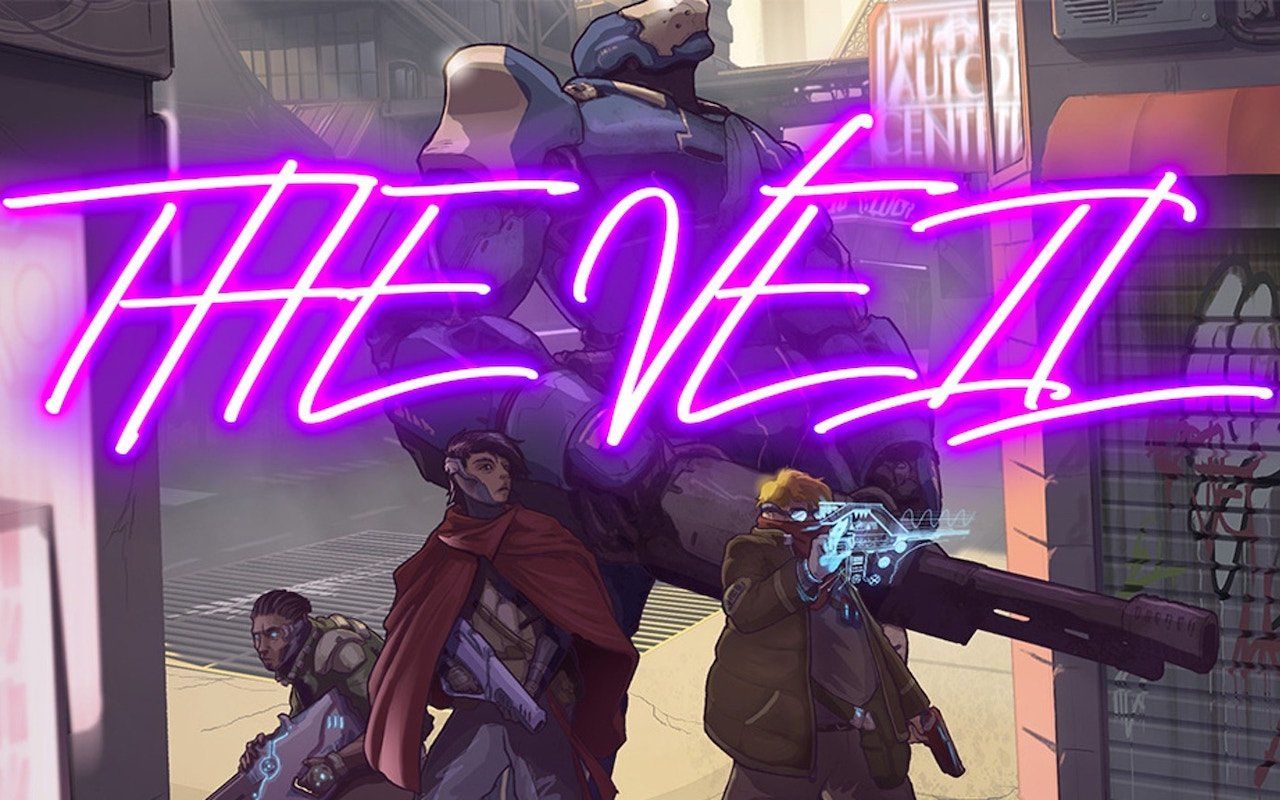How two books, one broken computer and an out-of-print tabletop game led to The Veil: Inheritance
After venturing into the post-cyberpunk scene, the aesthetics and philosophy of bio-punk were a natural next-stop for Fraser Simon's RPG.

Fraser Simon’s first cyberpunk roleplaying game invited players to explore their fears about the near future. With The Veil: Inheritance, he’s determined to let them look further into the future than ever before.
A stark contrast to the leather jackets and gnarled metal of Night City, Inheritance is billed as a blend of Cowboy Bebop and Blade Runner. If CD Projekt Red’s Cyberpunk 2077 was a lavish adaptation of what cyberpunk used to be, Fraser’s latest tabletop gaming effort tries to tackle what it has become.
Despite the lack of eccentric hairstyles and the emphasis on the politics of newly-colonised spaces, Fraser insists that Inheritance is arguably the most visibly cyberpunk of the series to date.
“It's the most synonymous with, I think, what people picture cyberpunk to be, whereas The Veil is like the opposite,” he said.
Author Fraser Simon’s first effort in the cyberpunk roleplaying space was a crowdfunding success story in 2016. Raising CA$15,000 (that’s Canadian, around $16,000 Australian) more than its original CA$7,700 goal, The Veil was published by Samjoko Publishing later that year.
Looking back, though, Fraser said it wouldn’t have happened without his brother.
While Fraser said that he remembers playing Dungeons & Dragons with his father when he was young, tabletop roleplaying games weren’t necessarily a big thing for him growing up. Or at least not as much of a big thing as they were for his brother Kyle.
In 2012, Kyle crowdfunded his first tabletop roleplaying game via Kickstarter: The Magicians.
The pitch? It was an urban fantasy roleplaying game set in a modern day version of Seoul, where the rules of the magic system taught you how to read and write Korean.
Kyle set the original fundraising goal at CA$3,000. The campaign ended with CA$34,000, approximately 1135 percent of the original target.
After the success of The Magicians, Fraser said that his brother attempted to ‘gateway’ him into more tabletop roleplaying games. He sent him the latest editions of popular games like D&D and Pathfinder.
It didn’t quite pan out. Fraser said that he eventually went so far as to go to a few local D&D Beyond events, but “had the worst time ever.”
It wasn’t until Kyle came out with a game based on the Powered-By-The-Apocalypse (PBTA) rule set - called Worlds in Peril - that Fraser found the system that would become the backbone of The Veil crossed his radar.
Unfortunately, there was just one problem. Fraser was trying to get into Apocalypse World at the worst possible time. The first edition of Apocalypse World had sold out, while the folks behind the game were gearing up to crowdfund the second edition via Kickstarter.
Fraser just couldn’t buy a copy of the original Apocalypse World rule book, even if he had wanted to.
In lieu of that, he got his hands on a PDF and watched a ton of Actual Play videos. For that reason, he describes The Veil’s emphasis on world-building as “his interpretation” of the Apocalypse World rules rather than a strict-adaptation.
At that time, Fraser was big into cyberpunk. He said that he “was just getting into it in novel form, which is why [The Veil] is so much different from other cyberpunk games out there.”
However, back then, there weren’t any supplements or “hacks” (essentially, modified versions of an existing roleplaying rule set) for the game that transplanted the Apocalypse World system into the cyberpunk genre. It was this gap in the market that motivated Fraser to put pen to paper, though he wasn’t the only one.
Fraser’s first entry into the cyberpunk roleplaying space was one of three similar projects in the works at that time. Fraser’s The Veil, Hamish Cameron’s The Sprawl and Mark Richardson’s Headspace all came out within the space of a year.
Looking back, Fraser calls Headspace “one of the most mechanical PBTA games that [he’s] ever played.”
“And then the Sprawl was just like playing a William Gibson novel, basically. So that was very fun. But also, by the end, you're depressed?”
Fraser’s own take on cyberpunk roleplaying was different to both. It has less number-crunching than Headspace, and was a little more optimistic than The Sprawl.
Characters in The Veil don’t have stats, they have emotions. Their ability to succeed or fail at rolls has less to do with how many agility points they have, and more to do with whether frustration makes them more or less effective at whatever they’re trying to do.
At its best, The Veil is about your character’s beliefs and how they square with the broader themes of the system’s cyberpunk sandbox. As a result, the game’s dozen or so Playbooks (an equivalent of classes in Dungeons & Dragons) are more cerebral and distinct than your usual jacket-clad shadow runners.
The Wayward raises the question of what the world outside the urban sprawl of The Veil’s cyberpunk dystopia looks like. Meanwhile, The Omnastic is the last of their kind. Hunted to extinction by an unknown threat known as the Iconoclasts, your character is charged with the protection of a powerful artefact known as a cybertome.
“It's got like a lot more influence of the actual, like literary fiction into it, which is usually why people are drawn to The Veil over other stuff I find,” Fraser said.
He describes The Veil as his “semi F.U. to the people who think that cyberpunk finished with Snow Crash.”
Fraser leaned even further in that direction with his 2017 follow-up, The Veil: Cascade.
Cascade introduced a set of new playbooks inspired by post-cyberpunk works like Altered Carbon and Strange Days, introduced flashbacks, and replaced the belief system with a new question-driven alternative. It even allowed players to bring their characters over from The Veil, transplanting them into new bodies, called sheathes.
Like its predecessor, The Veil: Cascade easily eclipsed its original crowdfunding target. Rather than raise CA$5,500 through Kickstarter, it raised CA$28,000.
While he was happy that the supplement was well-received, Fraser said that he wishes he had left more of a gap between Cascade and The Veil.
“I hadn't given enough people time to actually play The Veil enough to get to a point where they wanted to move their character over to Cascade.”
Even if the audience eventually caught up, Fraser said it feels like he moved too fast with Cascade. He suggested that Cascade didn’t quite deliver the same sales numbers initially as a result of that haste.
These regrets were part of the reason why the gap between Cascade and Inheritance is as long as it is. Well, that and the technical issues.
Fraser said that he always had three books in mind, and after The Veil: Cascade ventured into the post-cyberpunk scene, the aesthetics and philosophical questions raised by the bio-punk sub-genre were a natural next-stop.
The Veil: Inheritance was Fraser’s biggest Kickstarter success yet. Launched in early 2019, it delivered CA$37,000 on its original goal of CA$6,000.
At the time of writing, Fraser said that work on Inheritance is just about done. Assuming the game ships out to Kickstarter backers before the end of 2021, The Veil: Inheritance will be arriving 18 months after the estimated delivery date listed on the Kickstarter.
While that date was never set in stone, Fraser said that a big part of why Inheritance is arriving so late is down to bad luck and an even worse 2020. An extra year was added to the production timeline for Inheritance after a power outage fried the computer he used for work as it was uploading to Microsoft OneDrive.
For all his best attempts to recover the file, Fraser had to essentially start the entire manuscript from scratch.
“The extra year was basically just doing everything again, and having to play test the changes again, and then having to write it again. All that kind of stuff, and then I got COVID-19 too. That put me on my ass for like a whole month,” he explained.
Lost manuscripts aside, Fraser said that the most difficult element introduced in Inheritance was figuring out how piloting and mechs would work.
Early drafts saw vehicles in The Veil: Inheritance rely on very hard, prescriptive and mechanical moves. While this solution made vehicular combat more approachable, Fraser said that he found it boring and “was never super happy with it.”
At one point, he almost considered removing the pilot-centric playbook outright. In the end, he managed to find a solution that’s a little more in line with The Veil’s usual ethos. Now, every time a player enters battle, they roll up the stats for their vehicle or mech relative to their target.
In addition to liking “the idea of the target being completely different for everybody every single time,” Fraser said that this change made vehicle and mech combat “immediately more engaging, and more interesting.”
Asked what he makes of the explosion of interest in the genre over the last few years, Fraser laments the fact that CD Projekt Red’s Cyberpunk 2077 has so completely dominated public perceptions of the genre.
Fraser said that any of the subversive elements of cyberpunk as a literary movement might have had has quickly been co-opted by those seeking to make it palatable to the wider audience.
“I played the game, and I enjoyed it for what it was. But it really bugs me that they've made a literary genre so synonymous with a videogame that when I'm trying to talk to people about it, they literally sometimes don't know that it's a sub-genre.”
“They just think I'm talking about the videogame,” he said.
Back in his own exploration of the sub-genre, although Fraser originally envisioned The Veil as a three-book project, he admitted he might have one more supplement in him.
“I wouldn't mind doing a fourth Veil book, which is all setting potential - where I go through each different playbook and have numerous ideas for them, and then sort of populate it all into a setting.
“That way, if people wanted to generate a setting more completely than the playbook, but still have it reach back into the playbooks that they're choosing, then that would be a possible way to do it,” he said.
Byteside Newsletter
Join the newsletter to receive the latest updates in your inbox.



